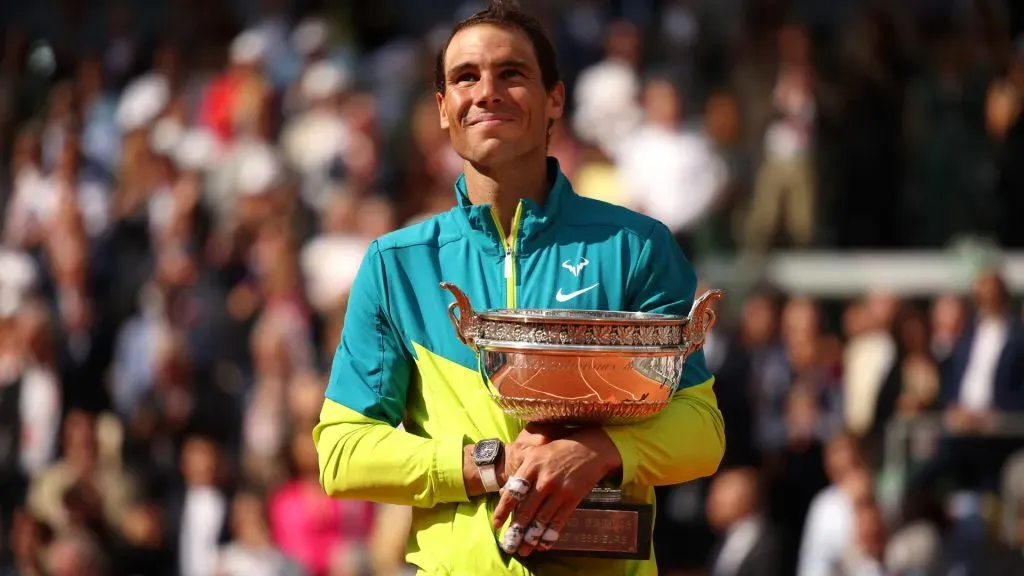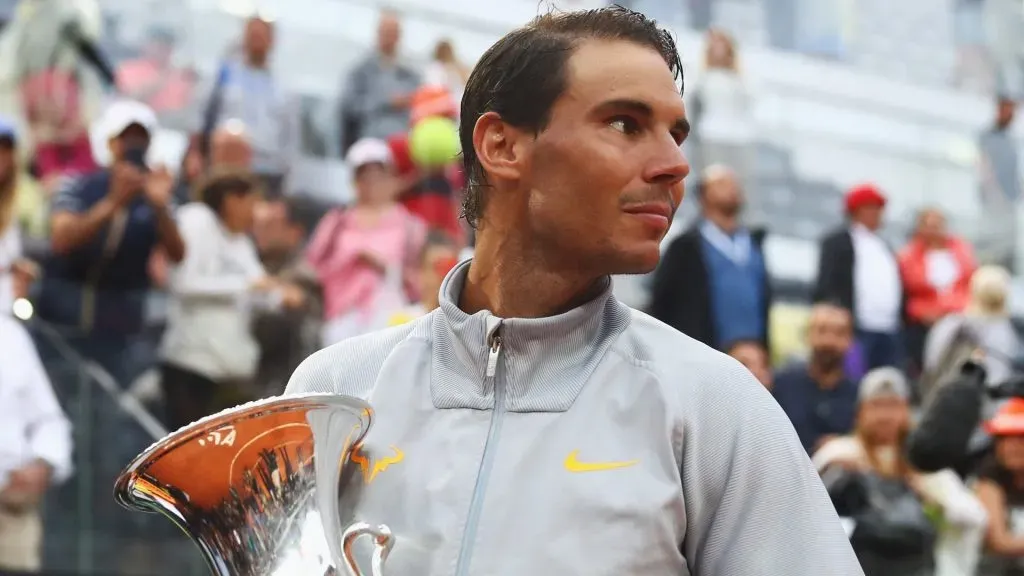In tennis, where records seem to be made to be broken, there are certain achievements that stand as eternal landmarks, monuments to unmatched greatness. These are not just numbers etched in history; they are stories of resilience, brilliance and moments that transcended the sport itself.
Think of Rafael Nadal’s commanding supremacy at Roland Garros, with 14 French Open titles won through effort and skill, or Steffi Graf’s Calendar Golden Slam in 1988, an extraordinary year in which she swept all four Grand Slams and the Olympic gold medal in a single season.
What makes these records truly special is their apparent invulnerability. Year after year, new players emerge with renewed energy and ambition, yet these achievements remain untouched, as if challenging the next generation to surpass them.
Rafael Nadal’s 14 French Open titles

Rafael Nadal of Spain poses with the trophy after winning against Casper Ruud of Norway during the Men’s Singles Final match on Day 15 of The 2022 French Open. (Source: Adam Pretty/Getty Images)
Rafael Nadal claimed his 14 Roland Garros titles between 2005 and 2022, an achievement that seemed unimaginable even in modern tennis. In 2005, he arrived in Paris as a 19-year-old with an impressive clay-court winning streak, having triumphed in Monte Carlo, Barcelona and Rome that year. On his debut, he not only defeated then-world No. 1 Roger Federer in the semifinals but also dominated Mariano Puerta in the final.
Each subsequent title came at different stages of his career: from a young and unstoppable Nadal to a resilient champion overcoming injuries, as seen in 2022 when he defeated Casper Ruud while battling a foot injury amid retirement rumors. His incredible longevity and consistency on the demanding clay surface earned him the nickname “The King of Clay“.
Rafael Nadal’s 22 Grand Slam titles

Rafael Nadal celebrates with the championship trophy during the trophy presentation ceremony after winning his Men’s Singles final on day fourteen of the 2019 US Open. (Source: Matthew Stockman/Getty Images)
Nadal’s first Grand Slam came at Roland Garros in 2005, but his transformation into a complete player was evident when he won Wimbledon in 2008 after an iconic final against Federer, widely considered the greatest match in tennis history.
Subsequent titles showcased his dominance across all surfaces: Australia (2009, 2022), Wimbledon (2008, 2010) and the US Open, where he secured four titles. His 22nd Grand Slam came at Roland Garros in 2022, a testament to his longevity and physical resilience even in his veteran years, as confirmed by the ATP Tour.
Nadal’s 81 consecutive wins on Clay

Rafael Nadal celebrates with the trophy after victory in his Mens Final match against Alexander Zvere during day 8 of the Internazionali BNL d’Italia 2018 tennis. (Source: Dean Mouhtaropoulos/Getty Images)
From April 2005 to May 2007, Nadal achieved an unprecedented 81-match winning streak on clay, starting with his victory in Monte Carlo and ending in Hamburg, where he lost to Federer in the final.
This period included 13 clay-court titles, including three Roland Garros trophies. His consistency on clay during those years laid the foundation for his dominance in the following decade, according to ESPN.
Longest match in tennis history

John Isner of the United States (L) and Nicolas Mahut of France meet up at the net before their first round match on Day Two of the Wimbledon Lawn Tennis Championships. (Source: Michael Regan/Getty Images)
On June 22, 2010, John Isner and Nicolas Mahut began what would become the longest match in tennis history during a seemingly ordinary first-round encounter. Over three days, they battled for 11 hours and 5 minutes, with the final score ending 70-68 in the fifth set. Both players were at their physical peak, but their mental endurance stood out. Exhausted, Isner lost his next-round match in just 74 minutes, as reported by the BBC.
Jimmy Connors’ record for consecutive weeks in the top 10

A portrait showing Jimmy Connors of the United States during the Wimbledon tournament. (Source: Tony Duffy/Getty Images)
Jimmy Connors remained in the ATP Top 10 from 1973 to 1988, a record spanning more than 15 years. In an era without advanced recovery technology, Connors maintained his consistency through his aggressive playing style and unwavering determination. Even as competition intensified with players like Borg and McEnroe, he remained a contender at every tournament he entered.
Most titles at a single tournament by Rafael Nadal

Rafael Nadal of Spain celebrates winning his match against Jason Kubler of Australia during day five of the 2024 Brisbane International. (Source: Chris Hyde/Getty Images)
Nadal holds 14 titles at Roland Garros, 12 in Barcelona and 11 in Monte Carlo. These tournaments, pivotal to the clay-court season, became his battlegrounds where he defended his crown year after year against players from all generations. His ability to perform at peak levels under the pressure of defending historic points and titles makes this record unassailable.
Novak Djokovic’s record for weeks at World No. 1

Novak Djokovic of Serbia celebrates after a point against Daniil Medvedev of Russia during their Men’s Singles Final match on Day Fourteen of the 2023 US Open. (Source: Elsa/Getty Images)
In March 2021, Novak Djokovic broke Roger Federer’s record by reaching 311 weeks as world No. 1. Since then, he has extended this milestone, accumulating over 373 weeks at the top of the ATP rankings (as of 2024). This achievement highlights his consistency, versatility and ability to excel on all surfaces.
He first ascended to No. 1 in July 2011 after winning Wimbledon and completing one of the best seasons in tennis history with 10 titles, including three Grand Slams. His return to the top after recovering from injuries in 2018 was particularly remarkable, showcasing his resilience. His strategic approach to tournament selection, focusing on high-impact events, has been crucial to this record.
Venus Williams’ 35 consecutive Wimbledon wins

Venus Williams of United States plays a backhand during a practice session ahead of The Championships – Wimbledon 2023 on July 01, 2023. (Source: Clive Brunskill/Getty Images)
Between 2000 and 2005, Venus Williams achieved an extraordinary streak of 35 consecutive wins at Wimbledon, a feat that continues to define her legacy. During this period, she secured five titles at the All England Club, combining a powerful serve—one of the best in women’s tennis history—with exceptional court coverage.
The streak included memorable victories, such as the 2005 final against Lindsay Davenport, where she saved a match point to win in what was then the longest women’s final in Wimbledon history. This era represented the peak of her career, showcasing an unmatched blend of physical and mental strength, as noted by Wimbledon’s official site.
Martina Navratilova’s 74-match winning streak

Martina Navratilova returns the ball during a Wimbledon match against Peanut Louie in 1984. (Source: Steve Powell /Allsport)
Martina Navratilova set her record of 74 consecutive wins in 1984, a streak that included 13 consecutive titles on various surfaces. Her adaptability across grass, clay and hard courts was particularly impressive during an era when surface transitions were highly challenging.
That year, she won Wimbledon and the US Open, defeating top competitors like Chris Evert multiple times. Her focus on physical preparation and tactical innovation, particularly her aggressive net play, kept her invincible for much of the year. The streak ended in the 1984 Australian Open final, where she was defeated by Helena Suková.
Björn Borg’s 41% Slam conversion rate

Björn Borg of Sweden goes low to play a shot during a match at the Wimbledon Tennis Championships, July 1979. (Source: Getty Images)
Björn Borg competed in 27 Grand Slam tournaments and won 11, achieving a 41% conversion rate. This statistic is even more remarkable considering that Borg never participated in the Australian Open after 1974, limiting himself to the other three Slams.
From 1974 to 1981, he dominated Wimbledon and Roland Garros like no one before, winning six titles in Paris and five consecutive titles in London. His ability to excel on two vastly different surfaces—clay and grass—combined with his calm demeanor, physical fitness and revolutionary topspin technique, made him an unstoppable force in critical moments.
Steffi Graf’s Golden Slam in 1988

Steffi Graf plays a forehand return against Martina Hingis of Switzerland during their Women’s Singles First Round match at the Wimbledon Lawn Tennis Championship on 27th June 1995. (Source: Allsport/Getty Images)
In 1988, Steffi Graf accomplished the unparalleled “Golden Slam”, winning all four Grand Slam titles and the Olympic gold medal in Seoul within a single year. This achievement symbolizes perfection in tennis and came during an era of intense competition, with rivals like Martina Navratilova and Gabriela Sabatini.
She began the year by defeating Chris Evert at the Australian Open, swept through Roland Garros and Wimbledon, and overcame Sabatini in the US Open final. At the Olympics, she showed no signs of pressure, beating Sabatini again in the final. Her powerful forehand, agility and fierce mentality were crucial to this unique achievement, as highlighted by Olympics.com.





